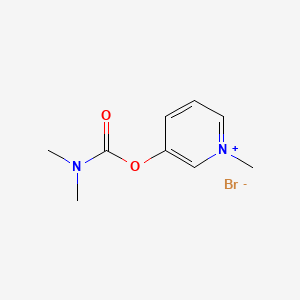Attribution Statement: LactMed is a registered trademark of the U.S. Department of Health and Human Services.
NCBI Bookshelf. A service of the National Library of Medicine, National Institutes of Health.
Drugs and Lactation Database (LactMed®) [Internet]. Bethesda (MD): National Institute of Child Health and Human Development; 2006-.
CASRN: 101-26-8

Drug Levels and Effects
Summary of Use during Lactation
Because of the low levels of pyridostigmine in breastmilk, amounts ingested by the infant are small and infant serum levels are very low. Pyridostigmine is not expected to cause any adverse effects in breastfed infants. Most mothers with myasthenia gravis are able to nurse successfully with pyridostigmine treatment, but occasionally breastfeeding must be discontinued to avoid excessive fatigue in the mother.
Drug Levels
Maternal Levels. A woman was taking pyridostigmine 120 mg every 4 to 5 hours for myasthenia gravis during pregnancy. After delivery, she had an undetectable (<100 mcg/L) pyridostigmine level in breastmilk 120 minutes after a 60 mg oral dose.[1]
A mother who was taking pyridostigmine 60 mg 3 times daily (3 mg/kg daily) had milk pyridostigmine levels ranging from 13 to 24 mcg/L at various times during the 8-hour dosage interval at 5 and 35 days postpartum. At 102 days postpartum while taking 40 mg twice daily (2 mg/kg daily), milk pyridostigmine levels ranged from the limit of detection (2 to 5 mcg/L) to 5 mcg/L during a dosage interval. The time of the peak milk level was about 4 hours after a dose. Another mother who was taking pyridostigmine 60 mg 5 times daily (5 mg/kg daily) had milk pyridostigmine levels of 25 and 22 mcg/L at the time of a dose and 2.5 hours after a dose, respectively, at 60 days postpartum. The authors estimated that an exclusively breastfed infant would receive a maximum of 0.1% of the maternal weight-adjusted dosage.[2]
Infant Levels. In an exclusively breastfed 60-day-old infant whose mother was taking pyridostigmine 60 mg 5 times daily (5 mg/kg daily), the drug was not detectable in serum (<2 mcg/L) at the time of a dose or 2.6 hours later.[2]
Effects in Breastfed Infants
A woman was taking pyridostigmine 120 mg every 4 to 5 hours for myasthenia gravis. Her breastfed (extent not stated) infant reportedly thrived and had no cholinergic side effects.[1]
Two infants whose mothers were taking pyridostigmine 3 and 5 mg/kg daily during pregnancy and lactation were exclusively breastfed. Both infants gained weight and developed normally and had no signs of cholinergic side effects.[2]
Effects on Lactation and Breastmilk
Relevant published information in nursing mothers was not found as of the revision date. In animals, cholinergic drugs increase oxytocin release,[3] and have variable effects on serum prolactin.[4] The prolactin level in a mother with established lactation may not affect her ability to breastfeed.
In a case series of 69 pregnancies in 65 women with myasthenia gravis over 27 years, 49 patients received pyridostigmine during pregnancy and lactation. Lactation data were available for 33 patients, and 25 of them nursed successfully, although the number of these mothers who were taking pyridostigmine was not given. Nursing was sometimes disrupted to avoid exhaustion in the mother.[5]
Alternate Drugs to Consider
References
- 1.
- Skoglund RR, Roberts CC, Huddlestone J. The role of anti-acetylcholine receptor antibody in neonatal myasthenia gravis. Bull Los Angeles Neurol Soc. 1978;43:66–9. [PubMed: 757366]
- 2.
- Hardell LI, Lindström B, Lönnerholm G, et al. Pyridostigmine in human breast milk. Br J Clin Pharmacol. 1982;14:565–7. [PMC free article: PMC1427605] [PubMed: 7138742]
- 3.
- Clarke G, Fall CH, Lincoln DW, et al. Effects of cholinoceptor antagonists on the suckling-induced and experimentally evoked release of oxytocin. Br J Pharmacol. 1978;63:519–27. [PMC free article: PMC1668097] [PubMed: 566601]
- 4.
- Müller EE, Locatelli V, Cella S, et al. Prolactin-lowering and -releasing drugs: Mechanisms of action and therapeutic applications. Drugs. 1983;25:399–432. [PubMed: 6133737]
- 5.
- Djelmis J, Sostarko M, Mayer D, et al. Myasthenia gravis in pregnancy: Report on 69 cases. Eur J Obstet Gynecol Reprod Biol. 2002;104:21–5. [PubMed: 12128277]
Substance Identification
Substance Name
Pyridostigmine
CAS Registry Number
101-26-8
Disclaimer: Information presented in this database is not meant as a substitute for professional judgment. You should consult your healthcare provider for breastfeeding advice related to your particular situation. The U.S. government does not warrant or assume any liability or responsibility for the accuracy or completeness of the information on this Site.
- User and Medical Advice Disclaimer
- Drugs and Lactation Database (LactMed) - Record Format
- LactMed - Database Creation and Peer Review Process
- Fact Sheet. Drugs and Lactation Database (LactMed)
- Drugs and Lactation Database (LactMed) - Glossary
- LactMed Selected References
- Drugs and Lactation Database (LactMed) - About Dietary Supplements
- Breastfeeding Links
- PMCPubMed Central citations
- PubChem SubstanceRelated PubChem Substances
- PubMedLinks to PubMed
- Review Glycopyrrolate.[Drugs and Lactation Database (...]Review Glycopyrrolate.. Drugs and Lactation Database (LactMed®). 2006
- Review Pancuronium.[Drugs and Lactation Database (...]Review Pancuronium.. Drugs and Lactation Database (LactMed®). 2006
- Review Neostigmine.[Drugs and Lactation Database (...]Review Neostigmine.. Drugs and Lactation Database (LactMed®). 2006
- Review Mebendazole.[Drugs and Lactation Database (...]Review Mebendazole.. Drugs and Lactation Database (LactMed®). 2006
- Review Misoprostol.[Drugs and Lactation Database (...]Review Misoprostol.. Drugs and Lactation Database (LactMed®). 2006
- Pyridostigmine - Drugs and Lactation Database (LactMed®)Pyridostigmine - Drugs and Lactation Database (LactMed®)
Your browsing activity is empty.
Activity recording is turned off.
See more...
